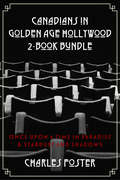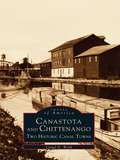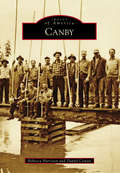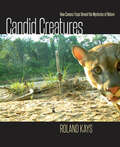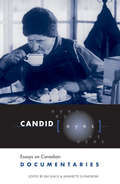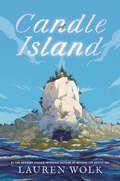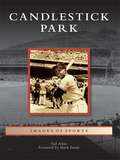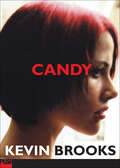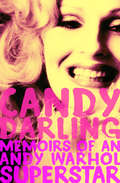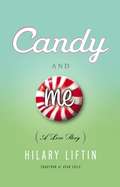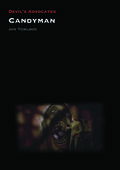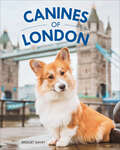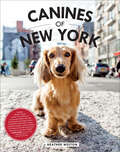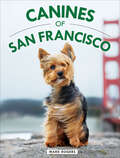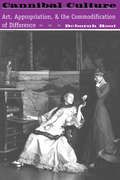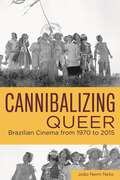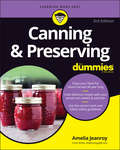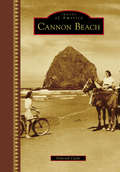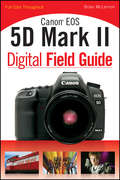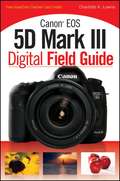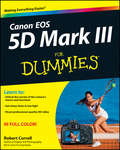- Table View
- List View
Canadians in Golden Age Hollywood 2-Book Bundle: Once Upon a Time in Paradise / Stardust and Shadows
by Charles FosterRevisit Hollywood’s Golden Age with insider Charles Foster, who befriended the many Canadian stars that peppered the film sets. Foster reveals the stories of the amazing influence Canadians had in the early days of the film biz. Includes: Stardust and Shadows: Canadians in Early Hollywood A Hollywood insider brings together the stories of eighteen Canadians who were celebrities during Hollywood’s formative years. Once Upon a Time in Paradise: Canadians in the Golden Age of Hollywood During Hollywood’s Golden Age, a bevy of talented Canadians earned important roles in the motion picture industry.
Canastota and Chittenango: Two Historic Canal Towns
by Lionel D. WyldCanastota and Chittenango share a growth spawned by the building of the Erie Canal, the longest continuous canal in the world. These two upstate New York communities also share much in addition to their canal related background, for both have a history of early settlement and townsfolk who were leaders in manufacturing, agriculture, industry, and state politics. Join author and historian Lionel D. Wyld in this exploration of the past through carefully preserved historic images. Canastota and Chittenango: Two Historic Canal Towns reveals the important link between these towns and a canal oncehailed as "the eighth wonder of the world." Both villages have canal related museums and parks today, in honor of the many ways in which the waterway influenced the communities. In a more popular realm, Chittenango boasts a unique annual Oz festival each May honoring native writer L. Frank Baum, authorof The Wonderful Wizard of Oz, and Canastota is home to the International Boxing Hall of Fame, founded in 1984.
Canby (Images of America)
by Daniel Cowan Rebecca HarrisonThe town of Canby is located in the North Willamette Valley, in Clackamas County, Oregon. By 1838, James Baker, one of the earliest European settlers in Oregon, came to Canby with a cattle drive from California. Soon, he and other settlers were farming on the rich soil. Joseph Knight and four sons moved to the area in 1868. They were active in early Canby development, starting many local businesses and setting the framework for a future town. Maj. Gen. Edward R.S. Canby, hero of the Civil and Indian Wars, had arrived in Oregon in February 1893 to take up command of the US Army's Department of the Columbia. The new town was given this brave man's name by his good friend Ben Holladay, chief of the Oregon & California Railroad. Canby was incorporated on February 15, 1893, making it the second-oldest city in Clackamas County.
Candid Creatures: How Camera Traps Reveal the Mysteries of Nature
by Roland KaysA riveting collection of photographs that captures wild animals in their native habitats.In Candid Creatures, the first major book to reveal the secret lives of animals through motion-sensitive game cameras, biologist Roland Kays has assembled over 600 remarkable photographs. Drawing from archives of millions of color and night-vision photographs collected by hundreds of researchers, Kays has selected images that show the unique perspectives of wildlife from throughout the world. Using these photos, he tells the stories of scientific discoveries that camera traps have enabled, such as living proof of species thought to have been extinct and details of predator-prey interactions.Each image captures a moment frozen in the camera’s flash as animals move through their wild habitats. Kays also discusses how scientists use camera traps to address conservation issues, creating solutions that allow humans and wild animals to coexist. More than just a collection of amazing animal pictures, the book’s text, maps, and illustrations work together to describe the latest findings in the fast-moving field of wildlife research. Candid Creatures is a testament to how the explosion of game cameras around the world has revolutionized the study of animal ecology. The powerful combination of pictures and stories of discovery will fascinate anyone interested in science, nature, wildlife biology, or photography.
Candid Creatures: How Camera Traps Reveal the Mysteries of Nature
by Roland KaysA riveting collection of photographs capturing wild animals in their native habitats and demonstrating the importance of camera traps.In Candid Creatures, the first major book to reveal the secret lives of animals through motion-sensitive game cameras, biologist Roland Kays has assembled over 600remarkable photographs. Drawing from archives of millions of color and night-vision photographs collected by hundreds of researchers, Kays has selected images that show the unique perspectives of wildlife from throughout the world. Using these photos, he tells the stories of scientific discoveries that camera traps have enabled, such as living proof of species thought to have been extinct and details of predator-prey interactions.Each image captures a moment frozen in the camera’s flash as animals move through their wild habitats. Kays also discusses how scientists use camera traps to address conservation issues, creating solutions that allow humans and wild animals to coexist. More than just a collection of amazing animal pictures, the book’s text, maps, and illustrations work together to describe the latest findings in the fast-moving field of wildlife research.Candid Creatures is a testament to how the explosion of game cameras around the world has revolutionized the study of animal ecology. The powerful combination of pictures and stories of discovery will fascinate anyone interested in science, nature, wildlife biology, or photography.“Full of fabulous pictures of weird and wonderful creatures . . . [Candid Creatures is] loaded with information and carries a strong conservation message.” —Conservation Biology
Candid Eyes
by Jeannette Sloniowski Jim LeachBeginning in 1922, when Robert Flaherty filmed 'Nanook of the North' in Canada's Arctic, and encouraged by John Grierson and the federal government in 1939 when they created the National Film Board of Canada (NFB), documentaries have dominated Canada's film production and, more than any other form, have been crucial to the formation of Canada's cinematic identity.Surprisingly, there has been very little critical writing on this distinguished body of work. Candid Eyes: Essays on Canadian Documentaries not only addresses this oversight in the scholarly literature, but in doing so, it presents an exceptional collection of essays by some of Canada's best known film scholars. Focusing on works produced in French and English under the NFB umbrella, the fourteen essays discuss and critique such landmark documentaries as 'Lonely Boy' (1962), 'Pour la suite du monde' (1963), and 'Kanehsatake' (1993). Long awaited and much needed, this volume will be an indispensable companion for anyone seriously interested in Canadian film studies.
Candle Craft, A Complete Guide: 23 Stylish Projects & Small-Business Tips
by Tiana CoatsStunning, safe custom candles made by you Craft a serene atmosphere with hand-poured candles and inspiring scents. Candlemaking is as rewarding as it is relaxing; you can enjoy custom scents, colors, and holistic ingredients in one-of-a-kind candles that match your style and home decor. Candle Craft is your one-stop guide to mastering the craft from start to finish. Cut through the online clutter and learn from accomplished candlemaking business owner Tiana Coats as she shows you how to create candles that match your desired aesthetic and burn safely. You'll also find tips on selling your candles and starting your own creative business. Simply and successfully bring a sense of serenity to your home with beautiful handcrafted candles in any shape, color, and scent you can imagine. Get started with more than two dozen projects basic and specialty projects! Learn to share your projects with the world with Tiana’s small business tips for starting and growing your own creative venture
Candle Island
by Lauren WolkA moving portrait of loss and the restorative power of art from Lauren Wolk, the Newbery Honor-winning author of Beyond the Bright Sea.Lucretia Sanderson has a secret.Lucretia and her mother have come to tiny Candle Island, Maine (Population: Summer, 986; Winter, 315) to escape—escape memories of the car accident that killed her father and escape the journalists that hound her mother, a famous and reclusive artist. The rocky coast and ocean breeze are a welcome respite for Lucretia, who dedicates her summer days to painting, exploring the island, and caring for an orphaned osprey chick.But Candle Island has secrets of its own—a hidden room in her new house, a mysterious boy with a beautiful voice—and just like the strong tides that surround the shores, they will catch Lucretia in their wake.With an unforgettable New England setting and a complex web of relationships old and new, Candle Island is a powerful story about art, loss, and the power of being true to your own voice.
Candlestick Park (Images of Sports)
by Mark Purdy Ted AtlasOpened in 1960 as the home of the San Francisco Giants, Candlestick Park is among America's most iconic sports facilities. It is a striking example of modernism and was the first reinforced-concrete stadium. The Giants' home for 40 years, it played host to two World Series, including in 1989, when it was infamously delayed by the Loma Prieta Earthquake. Renovated to a dual-purpose stadium in 1970, it became home to the San Francisco 49ers. In 1982, "The Catch," one of the most famous plays in NFL history, heralded the beginning of five Super Bowl Championships. Candlestick Park was also home to the early Oakland Raiders, was visited by Pope John Paul II, and saw the last Beatles concert.
Candy (A\través Del Espejo Ser.)
by Kevin Brooks“[A] provocative, suspenseful work . . . the story plays skillfully to teens’ curiosity about the mechanics of addiction and its manic, lurid subculture.” —BooklistWhen Joe meets Candy, it seems like a regular boy-meets-girl scenario. They chat over coffee, she gives him her number, and he writes her a song. But then Joe is drawn into Candy’s world—a world of drugs, violence, and desperation. As the dark truth about Candy’s life emerges, Joe finds himself facing real danger at every twist and turn. Soon Joe’s conflicting emotions begin to mirror Candy’s, and he understands that falling in love just might be worth the struggle. This intoxicating tale of heartache, danger, and hope will enthrall teen readers.“A story as sharp as the title is sweet, with something dark lurking inside and no cozy answers . . . Some words of warning: Candy may hook you too.” —The Guardian“Versatile English author Brooks infuses his latest tale with a romantic—even mythic—grandeur sure to enthrall his fans . . . This story’s gritty street smarts will keep thrill-seekers more than entertained, while Joe’s orphic rescue mission into the netherworld of addiction gives more thoughtful readers plenty to ponder.” —Publishers Weekly (starred review)“Brooks’s plotting is masterful, and the action twists and builds to a frenzied and violent climax.” —School Library Journal“Brooks is one of the best young adult writers around. Get this book. Word-of-mouth will do the rest” —The Irish Times
Candy Aisle Crafts
by Jodi LevineThe ultimate materials for fun, whimsical crafting are right in your grocery store! From party decorations to children's toys, from wearable art to cute gifts, you need look no further than your supermarket shelves for the materials to make these unique (and kid-friendly) food crafts. For special celebrations, rainy-day activities, and much more, treat yourself to the sweetest projects. Colorful candy canes are fashioned into heart-shaped necklaces, melted peppermints are molded into a festive bowl, cookies and ice cream cones are transformed into a fanciful castle, marshmallows are snipped into a polar bear, and gumdrops become everything from adorable frogs to bumblebees and ducks. Candy Aisle Crafts is packed with simple ideas for charming crafts that both kids and parents will love.
Candy Darling: Memoirs of an Andy Warhol Superstar
by Candy DarlingA look into what moved Andy Warhol&’s greatest muse Located at 33 Union Square West in the heart of New York City&’s pulsing downtown scene, Andy Warhol&’s Factory was an artistic anomaly. Not simply a painter&’s studio, it was the center of Warhol&’s assembly-line production of films, books, art, and the groundbreaking Interview magazine. Although Warhol&’s first Factory on East 47th Street was known for its space-age silver interior, the Union Square Factory became the heart, brain, eyes, and soul of all things Warhol—and was, famously, the site of the assassination attempt that nearly took his life. It also produced a subculture of Factory denizens known as superstars, a collection of talented and ambitious misfits, the most glamorous and provocative of whom was the transgender pioneer Candy Darling. Born James Slattery in Queens in 1944 and raised on Long Island, the author began developing a female identity as a young child. Carefully imitating the sirens of Hollywood&’s golden age, young Jimmy had, by his early twenties, transformed into Candy, embodying the essence of silver-screen femininity, and in the process became her true self. Warhol, who found the whole dizzying package irresistible, cast Candy in his films Flesh and Women in Revolt and turned her into the superstar she was born to be. In her writing, Darling provides an illuminating look at what it was like to be transgender at a time when the gay rights movement was coming into its own. Blessed with a candor, wit, and style that inspired not only Warhol, but Tennessee Williams, Lou Reed, and Robert Mapplethorpe, Darling made an indelible mark on American culture during one of its most revolutionary eras. These memoirs depict a talented and tragic heroine who was taken away from us far too soon.
Candy and Me
by Hilary LiftinAs a seven-year-old child, Hilary Liftin poured herself a glass (or two) of powdered sugar. Those forbidden cups soon escalated to pound bags of candy corn and multiple packets of dry cocoa mix, launching the epic love affair between Hilary and all things sweet. In Candy and Me: A Love Story, Liftin chronicles her life through candy memories and milestones. As a high school student, Hilary used candy to get through track meets, bad hair days, after-school jobs, and her first not-so-great love. Her sweet tooth followed her to college, where she tried to suppress the crackle of Smarties wrappers in morning classes. Through life's highs and lows, her devotion has never crashed -- candy has been a constant companion and a refuge that sustained her. As Liftin recounts her record-setting candy consumption, loves and friendships unfold in a funny and heartbreaking series of bittersweet revelations and restorative meditations. Hilary survives a profound obsession with jelly beans and a camp counselor, a forgettable fling with Skittles at a dot-com, and a messy breakup healed by a friendship forged over Circus Peanuts. Through thick and thin, sweet and sour, Hilary confronts the challenges of conversation hearts and the vagaries of boyfriends, searching for that perfect balance of love and sugar. Written with a fresh dry humor that will immediately absorb you into Liftin's sweet obsessions and remind you of your own, Candy and Me unwraps the meaning found in the universal desire for connection and confection. Treat yourself to Candy and Me -- being bad never read so good.
Candyman (Devil's Advocates)
by Jon TowlsonWhen Candyman was released in 1992, Roger Ebert gave it his thumbs up, remarking that the film was “scaring him with ideas and gore, rather than just gore.” Indeed, Candyman is almost unique in 1990s horror cinema in that it tackles its sociopolitical themes head on. As critic Kirsten Moana Thompson has remarked, Candyman is "the return of the repressed as national allegory": the film’s hook-handed killer of urban legend embodies a history of racism, miscegenation, lynching, and slavery, "the taboo secrets of America’s past and present."In this book, Jon Towlson considers how Candyman might be read both as a "return of the repressed" during the George H. W. Bush era, and as an example of nineties neoconservative horror. He traces the project’s development from its origins as a Clive Barker short story ("The Forbidden"); discusses the importance of its gritty real-life Cabrini-Green setting; and analyzes the film’s appropriation (and interrogation) of urban myth. The two official sequels (Candyman: Farewell to the Flesh [1995] and Candyman: Day of the Dead [1999]) are also considered, plus a number of other urban myth-inspired horror movies such as Bloody Mary (2006) and films in the Urban Legend franchise. The book features an in-depth interview with Candyman’s writer-director Bernard Rose.
Canines of London
by Bridget DaveyA joyful celebration of London’s vibrant dog community, Canines of London collects close to 300 engaging photos taken throughout neighborhoods and parks within this eclectic, dog-loving city. From English Bulldogs to Welsh Corgis, Golden Retrievers to Dachshunds, London is full of dogs and the people who love them. In Canines of London, dog photographer Bridget Davey gathers up close to 300 photos taken all around one of world's great dog-loving cities. Gaze upon delightful pups living large beside Buckingham Palace, the London Eye, Piccadilly Circus, and more. No London landmark is left unvisited, and no dog left unphotographed. The follow up to Weldon Owen’s Canines of New York and Canines of San Francisco, this is the perfect gift for dog lovers everywhere. DIVERSE BREEDS AND ICONIC LOCATIONS: Includes over 300 utterly delightful photographs of dogs out and about in London, from Big Ben to the London Eye to the local pub, plus captions that give cute details of each dog's personality. Sure to delight dog lovers everywhere. PERFECT FOR ANGLOPHILES: London is a world-class city beloved by those both in and out of the UK. it's also the most popular tourist destination in the world, attracting over 30 million international visitors every year. LATEST IN A SUCCESSFUL SERIES: Weldon Owen’s Canines of New York and Canines of San Francisco have pleased dog lovers across the world, and London is sure to be the most amazing dog destination yet.
Canines of New York (Canines Ser.)
by Heather WestonHundreds of photographs that “capture the essence and the heart of these wonderful creatures in glorious settings” (Julie Klam, New York Times-bestselling author).A visual celebration, Canines of New York collects more than three-hundred photographs taken by acclaimed Brooklyn-based photographer Heather Weston throughout the five boroughs of this incredible, dog-loving city. Featuring pups in every part of the Big Apple, from iconic landmarks to their owners’ brownstone steps, this is the perfect gift for every dog lover.“Weston’s love of both dogs and New York City shines in every funny, gorgeous photograph. She captures the special brightness dogs bring to big-city life, from the Bronx to the Battery and in every borough.” —E. Lockhart, #1 New York Times-bestselling author of We Were Liars“Whether it’s a Brooklyn pupster, a Bronx Bulldog, a canine commuter on the Staten Island Ferry or a group of buddies meeting at a Soho dog park, photographer Heather Weston perfectly captures what it means to be a dog in the City That Never Sleeps.” —Dogster“The perfect book to showcase some of New York City’s furry friends . . . displays practical, pompous, and pretty pooches like never before.” —Broadway World
Canines of San Francisco
by Mark RogersA joyful celebration of the canine community throughout every neighborhood in this passionate, dog-loving city from the acclaimed Bay Area photographer. In this book featuring some 300 photographs of the dogs that call The City by the Bay their home, acclaimed Bay Area and dog rescue photographer Mark Rogers has a unique talent for capturing each dog’s individual personality, as tiny puppies dominate even the most iconic landmarks. From the Golden Gate Bridge to Haight-Ashbury, from Alcatraz to the Embarcadero, this book is an adorable tribute to the city’s most fetching four-legged inhabitants.
Cannibal Culture: Art, Appropriation, and the Commodification of Difference (Icon Editions)
by Deborah RootIn Arizona, a white family buys a Navajo-style blanket to be used on the guest-room bed. Across the country in New York, opera patrons weep to the death scene of Madam Butterfly. These seemingly unrelated events intertwine in Cannibal Culture as Deborah Root examines the ways Western art and Western commerce co-opt, pigeonhole, and commodify so-called “native experiences.” From nineteenth-century paintings of Arab marauders to our current fascination with New Age shamanism, Root explores and explodes the consumption of the Other as a source of violence, passion, and spirituality. Through advertising images and books and films like The Sheltering Sky, Cannibal Culture deconstructs our passion for tourism and the concept of “going native,” while providing a withering indictment of a culture in which every cultural artifact and ideology is up for grabs—a cannibal culture. This fascinating book raises important and uncomfortable questions about how we travel, what we buy, and how we determine cultural merit. Travel—be it to another country, to a museum, or to a supermarket—will never be the same again.
Cannibalizing Queer: Brazilian Cinema from 1970 to 2015 (Queer Screens)
by João Nemi NetoThrough an analysis of contemporary Brazilian cinematic production, Cannibalizing Queer: Brazilian Cinema from 1970 to 2015 discusses which queer representations are erased and which are acknowledged in the complex processes of cultural translation, adaptation, and "devouring" that defines the Brazilian understanding of sexual dissidents and minorities. João Nemi Neto argues for Brazilian cinema studies to acknowledge the importance of 1920s modernism and of antropografia, a conceptual mode of cannibalism, to adopt and extrapolate a perverse form of absorption and raise the stakes on queer theory and postcolonialism, and to demonstrate how they are crucial to the development of a queer tradition in Brazilian cinema. In five chapters and two "trailers," Nemi Neto understands the term "queer" through its political dimensions because the films he analyzes represent characters that conform neither to American coming-out politics nor to Brazilian identity politics. Nonetheless, the films are queer precisely because the queer experiences and affection explored in these films do not necessarily insist on identifying characters as a particular sexuality or gender identity. Therefore, attention to characters within a unique cinematic world raises the stakes on several issues that hinge on cinematic form, narrative, and representation. Nemi Neto interviews and examines the work of João Silvério Trevisan and provides readings of films such as AIDS o furor do sexo explícito (AIDS the Furor of Explicit Sex, 1986), and Dzi Croquetes (Dzi Croquetes, 2009) to theorize a productive overlap between queer and antropofagia. Moreover, the films analyzed here depict queer alternative representations to both homonormativity and heteronormativity as forms of resistance, at the same time as prejudice and heteronormativity remain present in contemporary Brazilian social practices. Graduate students and scholars of cinema and media studies, queer studies, Brazilian modernism, and Latin American studies will value what one early reader called "a point of departure for all future research on Brazilian queer cinema."
Canning & Preserving For Dummies
by Amelia JeanroyGet your food preservation skills in the can Craving a juicy peach in the barren midwinter? Yearning for a cupful of home-grown tomato soup before the seeds are even in the ground? Canning makes you the ultimate boss of your food supply all year ‘round and helps you reduce costs and maintain quality control over what you eat—and to be prepared in times of food shortages. And Canning & Preserving For Dummies shows you how to do it all, helping you explore hundreds-of-years-old traditions of food preservation in the comfort of your own home. In a friendly and step-by-step style, longtime canner and owner of TheFarmingWife.com Amy Jeanroy takes you inside the canning world to show how modern technology and techniques have made it easy to use the four main methods of preservation—water-bath and pressure canning, freezing, and dehydrating—to keep your pantry packed with delicious, out-of-season delights. She also clues you in on how to match preservation technique to food for the most flavorful results—and what supplies to keep on hand for your next canning adventure. Know the benefits, from healthier eating to self-reliance Follow the latest food safety guidelines Get guidance on food storage in urban living Cook up tasty recipes with your preserved delights Whatever draws you to canning—saving money on groceries, healthy living, or the sheer fun of doing it—this book is stuffed with all the goodness you need to keep your palate happy whatever the season is!
Cannon Beach (Images of America)
by Deborah CuyleCannon Beach is a small town nestled off Highway 101 along the Oregon coast. It has been called one of the "World's 100 Most Beautiful Places" by National Geographic and one of "The 100 Best Art Towns in America" by author John Villani. Located 80 miles west of Portland and 25 miles south of Astoria, the town is surrounded by the Oregon Coast Range, ocean beaches, and rivers. Only four miles in length, and with a population of less than 2,000 residents, Cannon Beach is a popular and picturesque town catering to almost 1 million visitors annually. Life seems simpler, more beautiful, and quieter here. People stroll along holding hands, enjoying an ice cream cone or a latte, and daydreaming of building a fire later that evening on the beach. The salty air frizzes their hair, and sand is found in every shoe. But no one is bothered by this, because they are at Cannon Beach, with the legendary Haystack Rock.
Canon EOS 5D Mark II Digital Field Guide
by Brian MclernonEasy-to-understand techniques for getting the most from your Canon EOS 5D Mark II DSLRAt nearly $3,000 for the body only, the Canon 5D Mark II DSLR is for amateurs and semi-professionals who are serious about taking great photos-and this go-anywhere guide shares insight for doing just that. Authors Charlotte Lowrie and Brian McLernon walk you step by step through each function on the Canon EOS 5D Mark II, going into more depth and scope than the standard manual that accompanies the camera.Portable and easy to understand, the book shows you how to get the exact show you want, when you want them, and is packed with more than 200 beautiful color photos.Includes step-by-step techniques and professional tips on taking exceptional photos with your Canon EOS 5D Mark IIReviews how to better understand the various functions and potential of your Canon EOS 5D Mark IIFeatures samples of inspirational photos taken by the authorWith so much helpful advice for getting the most out of your Canon EOS 5D Mark II, you'll be referencing this guide again and again.
Canon EOS 5D Mark III
by James JohnsonThe Canon EOS 5D Mark III is the latest in Canon's line of full-frame DSLR cameras. Its impressive array of capabilities and advanced controls allow the photographer ever more influence over the final image. With this comes more menus, buttons, and dials that the photographer must learn how to use to take full advantage of the camera. This book explores the features and capabilities of the 5D Mark III in a way that far surpasses the user's manual. It guides readers through the camera features with step-by-step setting adjustments; color illustrations; and detailed how, when, and why explanations for each option. Every button, dial, switch, and menu configuration setting is explored in a user-friendly manner, with suggestions for setup. The informative text is illustrated with screenshots and example images throughout, making it easy to follow along. Author James Johnson covers everything from the basic features of the camera to the numerous advanced photographic options as he discusses topics such as focus and exposure, lenses, lighting, custom settings, and more. With this book as your guide, you'll learn how to get the most out of this powerful camera.
Canon EOS 5D Mark III Digital Field Guide
by Charlotte K. LowrieGuides you step-by-step through the functions on your new Canon EOS 5D Mark III dSLR cameraThe Canon EOS 5D Mark III full-frame dSLR camera features an impressive 22.3 megapixels, a 3.2-inch LCD screen, 6 fps continuous shooting, Live View, an ISO range of 50 to 102,400 and full HD 1080 resolution movie shooting. Here to help you get the most out of these remarkable features and offering you more in-depth coverage than the standard manual, this full-color Canon 5D Mark III Digital Field Guide provides you with guidance on how and when to use each button, dial, and menu option. Delivering information in an easy-to-understand format, this portable guide features more than 200 inspirational photos by acclaimed photographer and veteran author Charlotte Lowrie. The handy trim size allows this guide to go where you go, providing you with easy access to information quickly so you can get the exact shot you want when you want it.Helps you make the most of your Canon EOS 5D Mark III and get the shots you wantOffers full detailed coverage of when and how to use each and every button, dial, and menu option on this sophisticated new dSLRProvides step-by-step explanations on techniques and tips, all aimed at getting you comfortable and confident with your new Canon 5D Mark III Sized to fit in a camera bag, the book includes a bonus gray and color checker card to help you capture perfect white balance and color every time. Ideal reading for both amateur and professional photographers alike, you'll reference Canon 5D Mark III Digital Field Guide again and again.
Canon EOS 5D Mark III For Dummies
by Robert CorrellThe ideal reference to Canon's EOS 5D Mark III for professionals and serious hobbyistsThe Canon EOS 5D Mark III offers professional photographers and advanced amateurs a wide range of top-flight dSLR capabilities. Canon users love For Dummies guides, with more than 100,000 copies of previous Canon camera guides sold. Like its predecessors, this one is packed with colorful examples that illustrate camera features and inspire you to capture your own super images. It explains the camera controls and menus, shows you how to take full advantage of all the features, discusses output options and image editing, and much more.Geared to the needs of professional dSLR photographers and serious hobbyists, this guide covers all the features of the Canon EOS 5D Mark IIIExplores the camera body, menu screen, auto settings, and image settingsShows how to use the video modes, priority settings, manual settings, and focus modes to capture the best imagesProvides suggestions and inspiration with more than 300 full-color photosCovers image editing and output optionsFeatures tips, techniques, and projects to help you get the most from your camera's capabilitiesCanon EOS 5D Mark III For Dummies is the perfect partner for your new dSLR.
